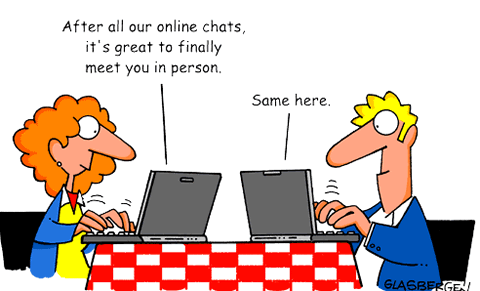Oxford Study Says - a third of us have used dating websites
 |
| From Good Old Chatings to People Now Moved to Online Dating |
An Oxford University study suggests that nearly one in three of us who use the internet have visited online dating sites. An international survey of 24,000 men and women who are presently online found that just six per cent had gone to dating websites in 1997 but by 2009, 30 per cent of the sample had tried them with 15 per cent finding their current partner that way.
The Oxford Internet Institute (OII) conducted an online questionnaire with 12,000 couples from 18 countries, all of whom had regular access to the internet. They were asked a series of questions about whether they had visited dating websites, other online services and where else they might go looking for a partner. The questions related to the period 1997 to 2009.
Middle-aged men and women (aged 40-69) looking to start new relationships after 1996 were the most likely to use online dating sites, with 36 per cent of them revealing that they had found their current partner online. The study dispels the myth that social networking and online dating is primarily for the young with just 23 per cent of 18-40-year-olds saying they had started a relationship through the internet. However, only two people in the sample started a relationship in their 70s and neither did this through the internet.
The study reveals to what extent chat rooms and social network sites have played a role in introducing people to their partners. For people who began their relationship before 2000, less than 10 per cent said they had met on a social networking site. But by 2005 that had doubled to 21 per cent, while the popularity of chat rooms declined over the same period.
Study co-author Dr Bernie Hogan, Research Fellow at the OII, said: ‘Finding your partner online was once regarded as a bit of a novelty, but this survey suggests it has become a common if not dominant way of meeting new partners, particularly if you are between 40 and 70 years old. Our questionnaire also reveals that people who know others who date online are more likely to try it and approve of it. Our study gives us some insight into the significance and impact of the internet and how it is affecting intimate relationships both online and offline.’

The Google Trends Of Match.com showing how the daily unique visitors almost doubled from Jan 2009 to Jan 2011
Religious events, family gatherings or activities based around a shared hobby are experiencing a slight decline in popularity as ways of finding a partner and this could be because they are viewed as less successful hunting grounds, says the study. Its expensive to go out to the bar or indulge your every social interest in the hopes of meeting someone new, and free dating sites (or even the least expensive) fit this bill nicely. Despite the recent spike in online dating, most of the sample said they had met their partner through traditional offline channels – through friends of friends (67 per cent) or meeting at clubs or bars (69 per cent).
Co-author and OII Director, Professor William Dutton, said: ‘When you ask the question “How did you meet?” the most likely answer is still “through mutual friends” or “at a club or bar”. But this study suggests there has been a noticeable shift in dating strategies. Men and women are seeing the internet as a new place to meet – another option for the networked individual. A growing number now view dating as a distinct and intentional activity with its own set of contexts and conventions. The popularity of online dating seems largely down to its accessibility and the fact that people seem comfortable disclosing what appear to be personal details in a “pseudo-anonymous” online setting.’
The study reveals there might be national differences in attitudes to online dating. Users in Northern European countries are slightly but significantly more likely to rely on one-to-one dating websites while those in Spanish and Portuguese-speaking nations are more likely to use social networking sites as well.
The most gregarious online nation appears to be Brazil – more than eight of out ten (83 per cent) of those interviewed who had access to the internet said they had met someone who had been first introduced to them online, but this was not just limited to personal relationships. By contrast, in Japan, a country known for embracing technology in so many ways, internet users were rather reluctant to engage with online dating.
Indian Scenario
India will be introducing the greatest amount of new users of online dating sites, with China in second, making online dating sites to prepare for an influx of new users.
Matrimonial sites thrive in India. Shaadi.com and others like Jeevansathi.com and Bharat Matrimony all have millions of users. The online matrimonial industry in India is estimated to generate $63 million a year in revenue and has tens of millions of registrants, according to EmPower Research, a market research firm.
“Dating sites have not succeeded in India,” says Gaurav Mishra of the MSL Group, a division of the marketing company Publicis Groupe. “It’s either been social networking sites or matrimonial sites.” Traditional dating sites, like Match.com, haven’t taken off in India.
But still One-fourth of the India's 81 Million Internet population do visit Dating websites.....
